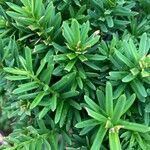Trees to 20 m tall; trunk to 1-1.5 m d.b.h.; bark reddish brown, with shallow fissures; winter bud scales persistent at base of branchlets, overlapping, ridged dorsally, tapered apically.Leafy branchlets "V"-shaped in cross section in living state. Leaves borne at 75-95° to branchlet axis, subsessile; blade dark green and glossy adaxially, linear, almost equally widethroughout length, slightly falcate, 1-2.5(-4) cm × 2.5-3 mm, midvein not papillate abaxially, stomatal bands tawny yellow, 0.6-0.7 mm wide, at least 2 × as wide as marginal bands,marginal bands ca. 0.2 mm wide, base cuneate, ± asymmetric, margin revolute, apex usually shortly mucronate, mucro 0.1-0.3 mm. Pollen cones ovoid or subglobose, ca. 3.5 mm;peduncle 0.5-1 mm; microsporophylls 9-14, each with 5-8 pollen sacs. Aril purplish red when ripe, lustrous. Seed ovoid or trigonous-ovoid, ca. 6 × 4-4.5 mm, distally with 3 or 4 or moreobtuse ridges, apex with small, obtuse mucro; hilum usually triangular or quadrangular. Pollination spring, seed maturity autumn.
More
A small evergreen tree. It grows 15 m high and spreads 6 m wide. The leaves are like needles and are single and keeled. They are sickle shaped. They tend to radiate out from the twigs. They are pale green above and have 2 yellowish-green bands underneath. The bud scales are triangle shaped. The pollen cones are small and in amongst the leaves. The fruit are small red berries.
Occasionally escape locally from cult.
Occasional in mixed conifer and conifer-deciduous forests in lowland to lower montane regions; at elevations from 100-1,600 metres. The var nana is found mainly on rocky sea coasts, sometimes also on exposed rock outcrops in the interior.
More
It is a temperate plant. They are hardy. It will grow in most alkaline soils. It needs an open, sunny position. It is resistant to drought. It suits hardiness zones 4-9. Hobart Botanical gardens.


